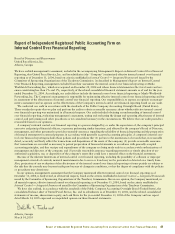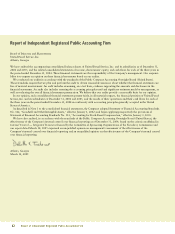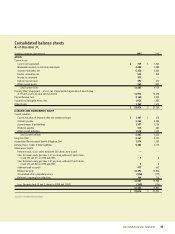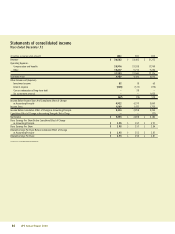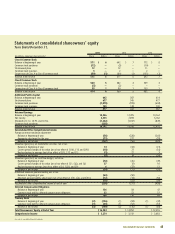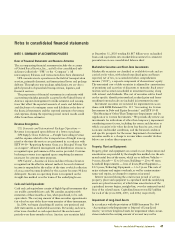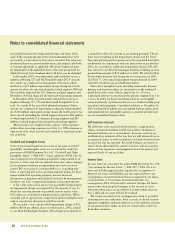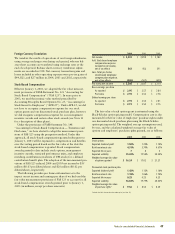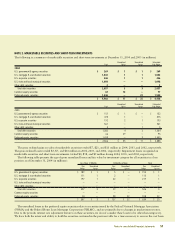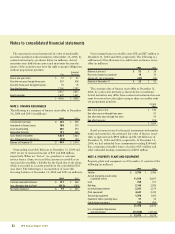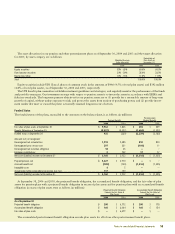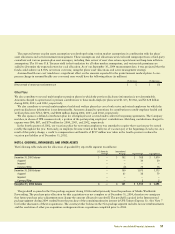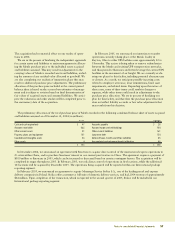UPS 2004 Annual Report Download - page 52
Download and view the complete annual report
Please find page 52 of the 2004 UPS annual report below. You can navigate through the pages in the report by either clicking on the pages listed below, or by using the keyword search tool below to find specific information within the annual report.
50 UPS Annual Report 2004
Notes to consolidated financial statements
Derivative Instruments
Derivative instruments are accounted for in accordance
with FASB Statement No. 133, “Accounting for Derivative
Instruments and Hedging Activities” (“FAS 133”), as amended,
which requires all financial derivative instruments to be recorded
on our balance sheet at fair value. Derivatives not designated as
hedges must be adjusted to fair value through income. If a deriv-
ative is designated as a hedge, depending on the nature of the
hedge, changes in its fair value that are considered to be effec-
tive, as defined, either offset the change in fair value of the
hedged assets, liabilities, or firm commitments through income,
or are recorded in OCI until the hedged item is recorded in
income. Any portion of a change in a derivative’s fair value that
is considered to be ineffective, or is excluded from the measure-
ment of effectiveness, is recorded immediately in income.
New Accounting Pronouncements
In December 2004, the FASB issued Statement No. 123 (revised
2004), “Share-Based Payment” (“FAS 123R”), which replaces
FAS 123 and supercedes APB 25. FAS 123R requires all share-
based payments to employees, including grants of employee
stock options, to be recognized in the financial statements based
on their fair values, beginning with the first interim or annual
period after June 15, 2005, with early adoption encouraged.
We will adopt FAS 123R in the third quarter of 2005, using the
prospective method of adoption. The prospective method
requires that compensation expense be recorded for all unvested
stock options and restricted stock at the beginning of the first
quarter of adoption of FAS 123R. There will be no impact upon
adoption, as we will already be expensing all unvested option
and restricted stock awards.
In December 2004, the FASB issued FASB Staff Position
(“FSP”) No. 109-2, “Accounting and Disclosure Guidance for
the Foreign Earnings Repatriation Provision within the
American Jobs Creation Act of 2004” (“FSP 109-2”). FSP 109-2
provides guidance under FAS 109 with respect to recording the
potential impact of the repatriation provisions of the American
Jobs Creation Act of 2004 (the “Jobs Act”) on enterprises’
income tax expense and deferred tax liability. The Jobs Act was
enacted on October 22, 2004. FSP 109-2 states that an enter-
prise is allowed time beyond the financial reporting period of
enactment to evaluate the effect of the Jobs Act on its plan for
reinvestment or repatriation of foreign earnings for purposes of
applying FAS 109. We have not yet completed our evaluation of
the impact of the repatriation provisions of the Jobs Act.
Accordingly, as provided for in FSP 109-2, we have not adjusted
our income tax provision or deferred tax liabilities to reflect the
repatriation provisions of the Jobs Act.
The adoption of the following recent accounting pronounce-
ments did not have a material impact on our results of
operations or financial condition:
nFASB Interpretation No. 45, “Guarantor’s Accounting and
Disclosure Requirements for Guarantees, Including Indirect
Guarantees of Indebtedness of Others — An Interpretation
of FASB Statements No. 5, 57, and 107 and Rescission of
FASB Interpretation No. 34”;
nFASB Interpretation No. 46(R), “Consolidation of Variable
Interest Entities — An Interpretation of ARB No. 51”;
nFASB Statement No. 132(R) (revised 2003), “Employer’s
Disclosures about Pensions and Other Post-Retirement
Benefits — An Amendment of FASB Statements No. 87, 88,
and 106”;
nFASB Statement No. 146, “Accounting for Costs Associated
with Exit or Disposal Activities”;
nFASB Statement No. 149, “Amendment of Statement 133
on Derivative Instruments and Hedging Activities”;
nFASB Statement No. 150, “Accounting for Certain
Instruments with Characteristics of Both Liabilities and
Equity”; and
nFSP 106-2, “Accounting and Disclosure Requirements
Related to the Medicare Prescription Drug, Improvement
and Modernization Act of 2003”.
Changes in Presentation
Certain prior year amounts have been reclassified to conform to
the current year presentation.



